
Gold tells 20th century
Cat: ECO
Pub: 1999
#:0224b
Toyoyuki Sameda
02531u/18129r
Title
Gold tells 20th century
金が語る20世紀
Author
Toyoyuki Sameda
鮫田豊之
Index
Why?
-
20th Century has various features: it is called
a century of war, technological advancement, atomic energy, ideology,
economic growth, explosion of population, and so forth.
-
>But here it is also a century of gold. This is
a history book written from the viewpoint of gold and exchange.
-
Note:
Au (from Latin Aurum) Atomic number is 79, Atomic weight is 197.0,
and most malleable and ductile of all the metals. It melts at
about 1064 deg.C and boils at about 2808 deg.C. Specific gravity
of 19.3. Mohs hardness is 2.5 -3. Abundance ratio is 75th in the
crust of the earth.
-
20世紀にはさまざまな特徴がある。それは戦争の世紀であり、技術革新、原子エネルギー、イデオロギー、経済成長、人口爆発、等々の世紀でもある。
-
しかしそれはまたゴールドの世紀でもある。この本は金および為替交換の視点から書かれた歴史書である。
-
注)
金(Auはラテン語のAurumから) は、原子番号79、原子量197.0、延性、展性に富む金属である。融点1064度C、沸点2808度C、密度19.32、モース硬度2.5-3、地核中の存在比は75位。
>Top Gold Reserve of sum of Japanese Government & Bank of Japan (1905-36,
1950-70, and 1998) Unit: Au. ton
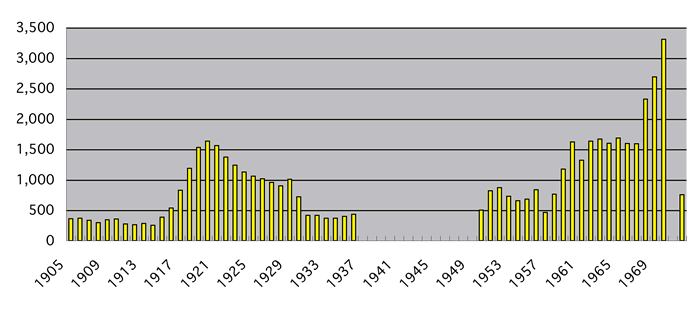
>Top 0. Gold Reserve of Japan:
- <The above graph>
The above is the total specie reserve of Japan (Government + Bank
of Japan) in terms of tons of gold.
- World gold production increased averagely 3% per year in 60 years
(1850 - 1910), scarcely exceeding economic growth of the same period.
- The total reserve of gold could be a barometer of the national
strength. Until the World War II gold ratio of the reserve was relatively
higher, which was called specie reserve for convertible currency.
- The reserve for foreign currency are usually indicated in prices,
which is not a proper tracer in the inflationary trend. US government
complies with the exchange into gold by the official rate of $35 per troy once (oz-t.; 31.1035 grams) The exchange market
of each country was backed by mostly US dollars which were convertible
to gold.
- But since the Nixon shock proclaimed in Aug. 1971, US dollar
became inconvertible to gold, virtually shifting to floating exchange
system.
- Under the gold standard system, one the trade deficit occurs,
it means outflow of gold reserve (gold coins, gold ingot, gold bullion
or other convertible exchange).
- In 1911 K. Takahashi, governor of BOJ: "The best way to maintain
the specie reserve is to develop domestic industry, but it requires
further inflow of the foreign currency."
- The specie reserve in overseas usually exceeds that of in Japan.
This trend becomes conspicuous in the years of inflow of large scale
foreign debt.
0. 日本の金準備:
- <上図>
日本 (政府・日銀)の金・外貨準備高の推移 (純金換算、単位トン)
- 世界の金生産は1850 - 1910年の60年間に年率3%で増加し、同期間の経済成長率を若干上回った。
- 金・外貨準備は国力のバロメーターになり得る。太平洋戦争前は外貨準備の中で金の比重が高く、金が兌換券の発行準備だったので正貨準備と呼ばれた。
- 外貨準備は一般に価格表示なので、インフレ傾向下では国力の変遷がたどれない。戦前は、米国は1トロイオンス=$35の公定価格で交換に応じた。各国通貨の相場は金の裏付けのある米ドルを中心に固定さえていた。
- 1971年8月のニクソン・ショック以降、米ドルと金との交換が停止され、実質的に変動相場制に移行した。
- 金本位制の下では、貿易収支が赤字であれば、やがては正貨 (金貨、金塊、金地金、これに代わり得る外貨) の流出を促す。
- 1911年高橋日銀総裁:「正貨維持には国内産業を発達させるのが何よりだが、それにはまだ外貨の流入を必要とする。」
- 海外正貨は、通常国内正貨を上回る。特に、大型外債の流入した年に著しい。
>Top 1. World
War I and Fall of Gold Standard:
- 1912: Powder magazine - Balkan peninsula
Germany-Austria-Turkey-Bulgaria (Pan-Germanism) vs. Russia-France-UK-Serbia
(Pan-Slavism)
- 1914: Prince & Princess Franz Ferdinand assassinated at Sarajevo
- 1914.7: World War I began in two weeks in Europe:
Germany-Austria-Turkey vs. Russia-France-UK
- 1914.8 Japan gate-crashed war, and occupied Qingdao.
- 1914: Collapse of Gold Standard; NY & London stock exchange
closed. Trench warfare both west and east front, escalating into
all-our war.
- 1915: Japan presents 21-terriotorial demands to China.
- 1915: Wartime export bubble: as World War I was protracted, import
slumped, while export was boosted by:
- supply of materials to the nations in the war.
- increase of export to Asian countries
- increase of export to
- historical record of trade surplus was 117 tons of gold;
- Japanese foreign reserve become 387 tons of gold.
The issue is not how to increase the overseas reserve, but how
to utilize the overseas reserve.
- 1916: Japanese foreign reserve 535 tons of gold.
- 1917.2: Unlimited attack by German submarines; US
- >Top 1917.11: Russian Revolution
- 1918: Naval blockade against Germany continued after cease fire.
- Loans to Czarist Russia became default. UK and France aimed
to repay US loans by German reparation, trying to return to
the Gold Standard soon.
- Severe food shortage in Germany
- German gold reserve: 810 tons "Starvation with gold coins
in their mouths."
- 1919.5: Paris Peace Conference: mainly lead by David Lloyd George
of UK, George Clemenceau of France, and Thomas Woodrow Wilson of
US, but defeated nations were not allowed to attend.
- 1919.6: US lifted the gold embargo (except Russia), returned to
the Gold Standard. But, Japan did not follow to Gold Standard System.
- 1920.1: League of Nations started (without US)
- 1920.12: UK, embargo on Gold & Silver.
- 1920: Japanese domestic reserve 837 tons exceeds that of overseas
796 tons.
1. 第一次大戦と金本位制の停止:
- 火薬庫バルカン半島:
独墺土ブルガリア (汎ゲルマン主義) 対露仏英セルビア (汎スラブ主義)
- 1914.6: 墺F.フェルディナンド皇太子夫妻、サラエボで暗殺される
- 1914.7: 第一次世界大戦勃発 (2週間で欧州戦争) 独襖土、対露仏英
- 1914.8: 日本、押しかけ参戦、青島占領
- 1914: 金本位制の崩壊:NY、ロンドン株式取引所閉鎖。東西前線での塹壕戦、総力戦へ
- 1915: 日、中国に21ヶ条要求
- 1915: 日、戦争が長期化し、輸入は低調だったが、輸出が急増した。
- 参戦国への軍需品の供給
- アジアへの輸出増加
- 米国への輸出増
- 過去に例のない貿易大幅黒字(金117トン相当)
- 外貨準備387トン
「どのように海外準備を補充するか」から「どのように海外準備を利用するか」が課題になった。
- 1916:日本、外貨準備535トン
- 1917.1: 米国ウイルソン、5項目の講和条件
- 1917.2: 独、無制限潜水艦作戦。米、独に宣戦布告
- 1917.11: ロシア十月革命
- 1918:休戦後も独封鎖を続行。
- 帝政ロシアに対する債権はロシア革命でゼロになった。英仏は独からの賠償金で米からの借款返済を目論み、早晩、金本位制への復帰を図った。
- 独での深刻な食糧難。
- 独、金準備810トン「金貨を口にくわえて餓死する」状態。
- 1919.5:パリ講和会議:実質的には、英(ロイド・ジョージ)、 仏(クレマンソー)、 米(ウイルソン) が主導、但し敗戦国は参加できず
- 1919.6:米、金輸出解禁(露を除く)、金本位制へ 。日、金本位制復帰に追従せず。
- 1920.1:国際連盟発足 (米国抜き)
- 1920.12:英、金銀輸出禁止法
- 1920:日、海外準備高796トン、国内準備837トンで、国内準備が海外準備を上回る
>Top 2.
Between World War I and II:
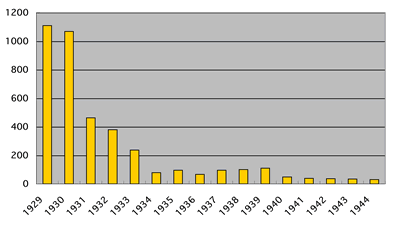 German Reserve of Gold & Foreign
Currency held by Deutsche Bundesbank (1929-44)
German Reserve of Gold & Foreign
Currency held by Deutsche Bundesbank (1929-44)
- 1919.7: Weimar Republic; President Friedrich Erbert. The total
amount of reparation was 300B Mark (=107,523 tons) required by UK
& France. Initial payment by 1921.4 was 20B Mark (=7,168 tons)
But German gold reserve was decreased to 402 tons in 1919. The reparation
could by paid not only by gold currency but in kind such as vessel,
coal, cattle, and timber.
- 1921.1: Allied Powers' concluded the total amount of reparation:
138B Mark (=49,460 tons) , with annual payment 2B Mark (=716 tons).
- 1920: Hyper inflation in Germany more than a trillion times. 100T
Mark note appeared.
- 1924.4: US Daws Plan: 1B Mark (1924-25), 1.22B
Mark (1925-26) and so on as tentative reparation.
- 1924.11: Germany returned to Gold Standard: 1 Reichsmark = 358.31
mg)
- 1929.1: US Young Plan: the remained total 3.58B Mark (=12,831
tons). Also BIS (Bank for International Settlements) was established.
- 1929.10: US NY Stock Exchange clashed (the Great Depression)
- 1930.5: Japan returned to Gold Standard.
- 1930: World Trade decreased over the previous year: -19% (nominal)
and -7% (apparent)
2.二つの大戦の間で:
- 1919.7:ワイマール共和国発足。エーベルト大統領;独の賠償金総額、英仏は3,000億マルク (107,523 tons)を想定。さしあたり1921年4月までに200億マルク
(7,168トン) の支払。 1919年の独の金準備は402トンに減少していた。賠償は、金貨でなく、商船、石炭、家畜、木材など現物でもよかった。
- 1921.1: 連合国国際賠償委員会の結論:1,380億マルク (49,460トン) 年賦額は20億マルク (716トン)
- 1920:独、超インフレ:1兆倍以上。100兆マルク紙幣が登場
- 1924.4:米、ドーズ案:10億マルク(1924-1925 )、 12.2億マルク(1925-26)など暫定支払案。
- 1924.11: 独、ライヒスマルク(358.31mg) を単位として、金本位制へ復帰
- 1929.1:米、ヤング案:国際決済銀行の設立。独賠償金残額358億マルク (12,831トン)
- 1929.10:米、NY取引所株価大暴落
- 1930.5:日、金本位制への復帰
- 1930:世界貿易、前年比-19% (名目)、-7% (実質)
>Top 3. World War II and Transport of Gold:
- 1936: Feb 26 Unsuccessful Coup d'etat in Japan;
Japan-Germany Anti-Comintern Pact (1937 Italy
joined)
- 1937: Exchange Control Law in Japan;
Japan-China War erupted.
- 1937: US Neutrality Act, revised
- BOJ report:
Japan must increase the import of not only producer goods but
consumer goods to keep expansion of heavy industry. As the export
of Japanese light industries was getting less competitive, the
export of heavy industry products seemed hopeless; enforcing
delivery of gold bullion to maintain the exchange rate.
BOJ estimated the possible deliverable gold bullion between
1937 -1941 will be 417 tons. (without breaking down of
BOJ's reserved 260 tons.)
- Japan deteriorated Gold/yen evaluation from 0.75 g/yen to
0.29 g/yen.
- Japan manipulated increase of apparent gold reserve by prior
issuance of gold receipt bond.
- 1938: upgraded to Japan-Germany-Italy Military Alliance: Japan
assumed Soviet as a possible enemy, while Germany required to include
the third nations (UK and France)
- >Top 1939.3.31 Gold Holdings:
- UK 1777; France 2,666; Canada 191; UK-France Dominion 480;
United Nations Total: 5,114 tons
- vs. Germany 133 tons (+ Illegal seizure 500 tons?
- Japan shipped Gold to US (1937-41): 608 tons (almost equivalent to \900B)
- BOJ Gold reserve: 91 tons (1952), surprisingly small.
- It sounds strange to deliver gold bullion to US to secure
military purchase for the possible war against US.
- 1939.7.26: US denounced US-Japan Commerce & Navigation Treaty
- 1939.8.20: Nohmonhan Incident
- 1939.8.23: German-Soviet Non-Aggression Pact concluded
- 1939.9.1: Germany invaded Poland; World War II erupted in Europe.
- 1939.9.17: Soviet invaded Poland.
- 1940: Germany invaded France; Japan, Germany & Italy Tripartite
Pact concluded.
- 1941: US Lend-Lease Act concluded; Japan-Soviet Neutrality Pact
concluded; Germany invaded Soviet Union; Japanese assets in US were
frozen; Oil embargo on Japan.
3. 太平洋戦争と金輸送:
- 1936: 2・26事件;日独防共協定 (1937 伊参加)
- 1937: 日、輸入為替管理令、 日中戦争開始
- 1937: 米、中立法改正
- 日銀の報告:
重工業部門の生産力拡充には生産財のみならず消費財原料の輸入増加が不可避。日本の軽工業品輸出の環境が厳しくなっているのに、重工業品を輸出する能力はまだない。為替相場を維持するには金塊の現送以外の方法はない。1937-41年までの金現送可能量は 417トンと推定 (日銀保有の260トンは取り崩さない)
- 金準備評価法などにより、0.75 g/円を 0.29 g/円に評価替え。
- 金地金の精製完了前に金地金預り証書により日銀保有金積み増し。
- 1938: 日独伊軍事同盟に格上げ。日本は仮想敵国ソ連、独は第三国(英仏)を含むこと要求。
- 1939.3.31: 欧州交戦国金保有高
- 英1777; 仏2666; カナダ191; 英仏領 480; 連合国合計: 5,114 トン
- 独133 トン(+ 非合法奪取500トン?)
- :日、対米金現送 (1937-41)608トン、(約9000億円相当)
- 日銀金準備 91トン (1952)異常に少ない量
- 金を米国に現送して、米国との戦争ための軍事物資を調達するのは奇妙である。
- 1939.7.26: 米、日米通商航海条約破棄
- 1939.8.20 ノモンハン事件
- 1939.8.23: 独ソ不可侵条約締結
- 1939.9.1: 独、ポーランド侵入;第二次世界大戦欧州で勃発
- 1939.9.17: ソ連、ポーランド侵入
- 1940: 独、仏に侵入。日独伊三国同盟締結
- 1941: 米、武器貸与法;日ソ中立条約;独、ソ連に侵入;在米資産凍結;対日石油禁輸
- >Top 1942-44: Transportation by submarines between Japan & Germany
(total 5 times); from Kure Naval Port, Hiroshima to Brest or Lorient
Naval Port in occupied France, spending 90 days, submerged most
of the day, surfaced in the midnight only. By this transportation,
Japan received submarine dumb, radar, bomber pointer, torpedo boat
engine in exchange for rubber, tin, tungsten, molybdenum.
- 1942.4.11: Japanese submarine i-30 shipped Kure:
On the way back from Singapore, it sunk by a mine
- 1943.6.1: Japanese submarine i-8 shipped
Kure:
Succeeded return trip.
- 1943.8: German submarine U511 arrived Kure:
- 1943.10.13: Japanese submarine i-34 shipped
Kure:
Outward trip after Singapore, it sunk by British submarine attack.
- 1943.11.5: Japanese submarine i-29 shipped Kure:
On the way back from Singapore, it sunk by US submarine attack.
- 1944.4.23: Japanese submarine i-52 shipped Singapore: Total crew126, delivering engineers to be
trained in Germany, with 2 tons of gold bullion. Japanese cryptogram
was decoded by US; the submarine was sunk by US carrier's attack.
This information was exposed in 1980 by US.
- 1944.5: German submarine U512: Outward trip, it was
sunk in the Atlantic ocean by US destroyer's attack.
- >Top 1941 -1945: Earmarked Gold:
- French Indochina: 33 tons
- Thai: 44 tons
- China: 53 tons
- "Was it exceptional that a nation which is just being
defeated has paid its war expenditure by gold bullion?"
(from a history of Yokohama-Shokin Bank), or was Japan relieved
from its debt by the enormous inflation?
- 1945.10.1: Army of Occupation surprised the smallness of gold
reserve at BOJ. Gold reserve: 91 tons (1952).
- 1942-44: 日本から独への潜水艦派遣(5回)
呉軍港から、シンガポール、ペナン、インド洋、喜望峰、ブルターニュ半島ブレスト軍港またはロリアン軍港(90日間)。ほとんど潜航し、深夜のみ浮上。
日本は、生ゴム、錫、タングステン、モリブデンと引換に、潜水艦方位盤、電波探知機、急降下爆撃照準期、高速魚雷艇エンジンを入手。
- 1942.4.11 日本潜水艦イ30号 呉出航
帰路シンガポール出航後、触雷沈没
- 1943.6.1: イ8号 呉出航:
往復路帰還
- 1943.8: 独潜水艦U511号呉到着
- 1943.10.13: イ34号 呉出航:
往路シンガポール出航後、英潜水艦に雷撃沈没
- 1943.11.5: イ29号 呉出航:
帰路シンガポール出航後、米潜水艦に雷撃沈没
- 1944.4.23: イ52号シンガポール出航:乗員126名。日本人技術者技術研修と引換に金塊2トン運搬。日本の暗号は米軍に傍受解読されていた。帰路米空母の攻撃にて沈没。
1980年に米国の軍事機密公開。
- 1944.5: 独潜水艦U512号、往路大西洋で米駆逐艦に撃沈された。
- 1941-1945: 金決済のイヤーマーク:
- 仏領インドシナ:33トン
- タイ:44トン
- 中国:53トン
- 敗戦の直前に金を以て軍費を弁済した例があろうか(横浜正金銀行全史)
あるいは、日本がインフレに救われたのか。
- 1945.10.1: 占領軍は日銀保管金塊の少なさに驚いた。 日銀金準備:91トン(1952)
>Top 4. Aiming
to be Economic Power:
-
1944.7: Bretton Woods Conference: United Nations
agreed the international monetary systems based on free trade.
- 1945.11-1946.10: Nuremberg Tribunal
- 1945.12: IMF (International Monetary Fund) and IBRD (International
Bank for Reconstruction and Development) established. £1=$4.03
- 1946.5-1948.11: International Military Tribunal for Far East ('Tokyo
Tribunal')
- 1947.5: Japanese constitution enforced.
- 1949.4: Joseph. M. Dodge's recommendation; $1=\360
- 1949.8: NATO established. (Greece and Turkey joined in 1952.2,
and W-Germany joined in 1955.5)
- 1949.9: BRD (BundesRepublik Deutschland) established; enforced
its constitution (1949.5).
- 1949.10: DDR (Deutsche Demokratische Republik) established; enforced
its constitution (1949.10).
- 1950.6 - 1953.7: Korean War; Japan enjoyed special procurement
boom amounting $980M (871 tons)
- 1950.7: EPU (European Payment Union) established; later reorganized
into EMA (European Monetary Agreement)
- 1951.6: GARIOA-EROA aid to Japan, and Marshall Plan to W-Europe
ended.
- 1952.4: Japan recovered independence (San Francisco Peace Treaty)
- Japan confirmed to succeed the prewar foreign liabilities.
13 kinds of £debts outstanding balance of£120M, 14 kinds of
$ debts outstanding balance of $126M, and one kind of FFr debt
outstanding balance of FFr437M.
4. 経済大国をめざして:
- 1944.7: 米ブレトンウッズでの連合国通貨金融会議
- 1945.11-1946.10: 独、ニュルンベルグ国際軍事裁判
- 1945.12: IMFおよび世界銀行(IBRD)設立。
£1=$4.03
- 1946.5-1948.11: 日、極東国際軍事裁判
- 1947.5: 日本国憲法施行
- 1949.4: ドッジ勧告で$1=\360
- 1949.8: NATO発足 (ギリシャ、トルコ加盟は1952.2、西独加盟1955.5)
- 1949.9: ドイツ連邦共和国(BRD)成立;独、ドイツ連邦共和国基本法 (1949.5)
- 1949.10: ドイツ民主共和国(DDR)成立;ドイツ民主共和国憲法 (1949.10)
- 1950.6 - 1953.7: 朝鮮戦争。
日本の朝鮮特需 $980M (871トン)
日本経済を活性化。
- 1950.7: 欧州支払同盟成立、欧州通貨協定(EMA)に発展的に解消
- 1951.6: ガリオア・エロア対日援助、マーシャルプラン対西欧援助打ち切り
- 1952.4: 日本、独立を回復 (サンフランシスコ条約)
- 日本は戦前の対外債務の継承を確認:
英貨13銘柄、未償還元利£120M、米貨14銘柄、未償還元利 $126M、仏貨1銘柄、未償還元利 FF437M
-
>Top US Gold Reserve (1945 - 1959)
-
US Gold reserve; amounting 21,707 tons in 1949 maximally.
- Period of
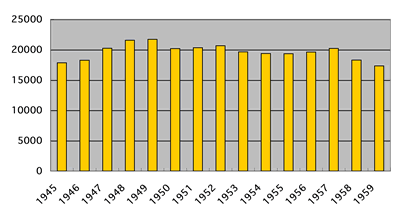 High-growth economy:
High-growth economy:
- 1952.5: Japan joined IMF and IBRD; paid-in capital $200M, 75%
by yen and 25% by gold (15 tons)
- 1952 - 1965: Introduction of foreign capital, amounting $860M
(764 tons)
- 1954: End of removal of reparations. But until then;
- USSR: took from E-Germany $13B (11,552 tons)
- The West Allies: took from W-Germany $517M (459 tons)
- 1956.7: Japanese Economic White Paper said, "No more postwar"
- 1957.3: EEC established by 6 countries.
- 1958.10: France President Charles de Gaulle: Cinquieme Republique
after Algerian war and 1/100 denomination in 1960.1.
- 1960.7: Japanese Ikeda Cabinet: "Income-doubling program"
- 1960: US dollar's purchasing power declined about 40% of 1934.
- 1961.2: W-Europe liberalized overseas travel, while Japan from 1964.4.
- 1963.1: Paris-Bonn Axis (Elysee Treaty)
-
<左図> 米国、金保有高 (1945-59)
- 金の米国への集中。絶頂期は1949年末(21,707トン)。
- 高度成長時代:
- 1952.5: 日本、IMFと世界銀行に加盟。払込額は2億ドル、内75%は円貨、25%は金(15トン)
- 1952 - 1965: 外資導入、合計 $860M (764トン)
- 1954: 賠償撤去中止。既存設備を利用した早期復興重視。それまでは
- ソ連:東独から$13B (11,552トン)
- 西側:西独から$517M (459トン)
- 1956.7: 日本の経済白書: "もはや戦後ではない"
- 1957.3: 欧州6ヶ国によるEEC発足
- 1960.7: 池田内閣「所得倍増計画」
- 1960: 米国のドル購買力は1934年の約40%に下落した。
- 1961.2: 西欧、海外旅行自由化。日本の自由化は1964.4から。
- 1963.1: パリ・ボン枢軸 (エリゼ条約)
-
>Top Gold Reserve of UK/France/W-Germany/Japan (1950-60):
- Miracle economic recovery: West Germany showed 7.9% growth in 1950s,
exceeding France in 1952, Japan in 1953, and UK in 1955 in terms
of gold reserve. The main reason for this growth due to active export
of producers' goods to other European countries. German industry
evacuated to escape from US bombing during the war. The damage ratio
was estimated less than 20%.
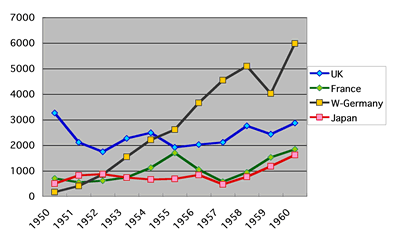
- 1963 - 69: Euro Dollar market grew from $5M (4,443 tons) in 1963
to $37.5M (33,325 tons) in 1969, mainly derived from excess of dollar,
and unregulated from governments.
- 1967.11: Pound crisis; £1=$2.40
- 1968: Japan changed into the constant trade surplus trend from1968,
attaining gold reserve 2,326 tons in 1968.
- 1968.5: Paris Peace Conference to settle Vietnam war; agreed in
1973.1.
- 1969: Japan became a supplier of funds into IBRD.
- 1970.8: Oder-Neisse Line became border between Poland and E-Germany.
- 1971.8.15: Nixon shock: suspended conversion between dollar and gold; for fear of decrease
of gold reserve less than $10B calculated by official rate of conversion
(=8,887 tons)
- tried to maintain Gold Parity: $35/oz-t Au ($1,125/kg Au)
- 1971.12 but US and France agreed new Gold Parity: $38/oz-t
Au ($1,222/kg)
- 1971.12 - 1973.3: New rate after G10 Smithsonian
Agreement; returned to fixed exchange system with
plus and minus 2.25% allowance. <Cf: Right column>
- 1972.5: Return of Okinawa island to Japan; exchange rate \305
- 1973.5: W-Germany and E-Germany joined UN.
- 1973.3: Collapse of Smithsonian System: shifted
to Dirty Floating Rate System
<左図>英/仏/西独/日の金準備高 (1950-60):
- 奇跡の復興:西独は1950年代の成長率7.9%達成し、金準備高で、1952年に仏を、53年に日本を、55年に英国を追い越した。この成長の主因は他の欧州諸国向けの活発な生産財の輸出であった。独は、工場を疎開したので、米国空襲による被害率はせいぜい20%以下と推定。
- 1963 - 69: ユーロ・ダラー市場は1963年の50億ドル(4,443トン)から1969年の375億ドル(33,325トン)に成長。主に過剰ドルに起因し、政府の規制を受けない。
- 1967.11: 英、ポンド危機; £1=$2.40
- 1968: 日本、国際収支黒字定着は1968年から (金準備 2,326トン)
- 1968.5: ベトナム戦争終結のためのパリ和平会議(1973.1和平協定締結)
- 1969: 日本は世界銀行の資金供給国へ
- 1970.8: オーデル・ナイゼ境界線でポーランドと東独との国境を確定
- 1971.8.15: ニクソン・ショック;金・ドル交換停止
。米国は公定価格で$10B (8,887トン) の金保有を絶対条件としてきたが、これを割り込む恐れがでてきた。
- 金平価は、当初$35の公定価格を据え置こうとしたが、1971.12に米仏が引き上げで合意( $38/トロイオンス)
- 1971.12 - 1973.3:スミソニアン合意後の新レート。上下委2.25%を許容範囲とする固定相場制に復帰
<下表>
$1
=BFr 44.8159
11.57% down
=FFr 5.1157
8.57% down
=DM 3.2225
13.58% down
=L 581.5
7.48% down
=\ 308
16.88% down
=Fl 3.2447
11.57% down
=SFr 3.85
6.36% down
£1
=$ 2.6054
8.57% down
Au parity
1oz.t
=$38
7.89% down
- 1972.5: 沖縄変換;為替レート\305
- 1973.5: 西独・東独、国連に加盟
- 1973.3: スミソニアン体制の崩壊;変動相場制(中央銀行の介入あり)へ移行
>Top US/Swiss/W-Germany/Japan Gold Reserve
& Foreign Currency Reserve (1955 - 1970):
- The bottom figures show that the reserve of 4 major countries. Such
reserve includes gold and foreign exchange, but not includes reserve
tranche from IMF. However, US reserve was only gold by 1963, but
includes foreign exchange after 1964. West Germany exceeded this
reserve amount over US in 1970.
<下図> 米・スイス・西独・日の金準備高+外貨準備高(1955-1970):
- 以下の表は4主要国の準備高を示す。これらの準備高には金と外国為替を含むが、IMFからの自由引き出し分は含まない。なお、米国は1963年までは準備は金だけだったが、1964年以降は外国為替を含む。西独はついに1970年に米国を抜いた。
>Top US/Swiss/W-Germany/Japan Gold Reserve
& Foreign Currency (1955 - 1970):
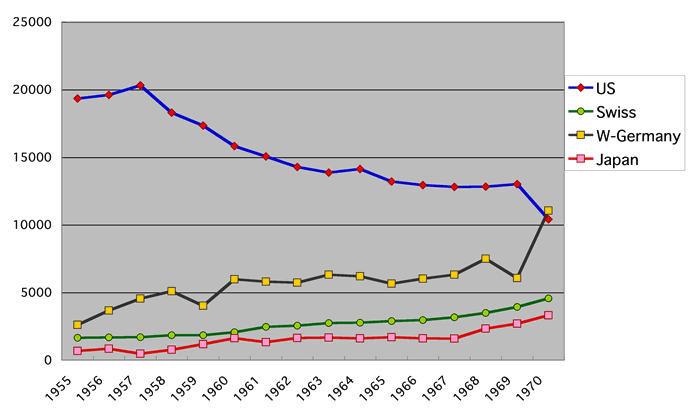
>Top 5.
Uncharted Navigation:
- 1973 - : Floating foreign exchange
system; surge to Yen appreciation
- 1973.2: US announced new Gold parity: $42.22/oz-t Au
- Gold market: $86/oz-t Au ($27,650/kg)
- 1973.2: First Oil Crisis arose:
- 1973-74: Fourth Middle-East War (Yom Kippur War) erupted.
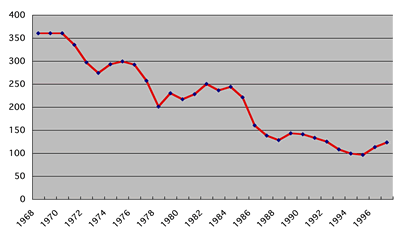 Yen exchange rate (1968
- 1997):
Yen exchange rate (1968
- 1997):
The year average rates were around \200 by 1985, but showing higher
yen & lower dollar since then.
- 1976.6 - 1980.5: IMF reserve 4,665 tons; 1/6 (777 tons) was returned
to the investor at the former parity, and another 1/6 was sold in
the market.
- 1979.1: Iranian Revolution. Ayatollah R. Khomeini returned.
- 1979.3:EMS (European Monetary System) established; currency basket
system (ECU) with 20% pooled gold and dollar reserve from members.
- 1979: Second Oil Crisis
- 1980-1988: Iran-Iraq War
- 1980-1988: Reaganomics and higher dollar & lower yen.
- 1981: Mexico; cumulative external debt problem, devaluating Peso
by 41%.
- 1985.9: Plaza accord aiming lower dollar: exchange intervention
target: $1=DM2.5=\200
- 1986: Japanese lower central bank rate policy: trigger for bubble
economy. World lowest bank rate 2.5% (1987.2), while US 5.5%, Swiss 3.5%, Germany 3%.
- Bubble at World War I occurred at commodities trading, but
this time was bubble at stock market and real estate.
- 1989.11-12: Dismantling of the Berlin Wall; End
of the Cold War declared.
- >Top 1990.8: Iraq invaded Kuwait. Gulf War (1991.1)
- 1990.10: Reunification of Germany
- 1991.12: Treaty on European Union (Maastricht Treaty);
USSR disappeared and 11 CIS (Commonwealth of Independent States)
established.
- 1993.8: Japanese Hosokawa Coalition Cabinet
- 1995: Japan full of difficulties:
- 1995.1: Kobe earthquake
- 1995.4: Historically higher yen $1=¥79; Orderly Reversal declared
by G7 (Concerted intervention of buying dollar)
- 1995.4: Collapse of Bubble economy
- 1995.9: Historically lower bank rate 0.5%
- 1995: Asian currencies maintained US dollar pegging system to
keep lower yen and higher dollar to increase each export competitiveness.
- 1997.11: Sanyo Securities, Hokkaido Takushoku Bank, Yamaichi Securities
broken up.
- 1997: SE-Asian currencies plunged:
- Indonesian Rupia: -58%
- Thai Baht: -45%
- Malaysian dollar・ドル: -35%
- Philippine Peso: -34%
- Singapore Dollar: -17%
- HK Dollar and Chinese Yuan maintained US dollar pegging system,
asking US to buy yen and sell US dollar.
- 1998.4: revised Bank of Japan Law revised, enhancing BOJ's independence.
- 1998.10: Russian Currency crisis, shifted to de facto floating
system.
- 1999.1: "Euro" introduced by 11 EU countries except
UK, Sweden, Denmark, Greece; ECB (European Central Bank) established;
- Price gap among countries became obvious due to the differences
of tax, distribution cost, finance and employment policies.
- Euroland 11 central banks' reserves: Foreign currency 277B
Euro, Gold 100B Euro (26.4%).
- 1999.1: Brazilian Currency crisis, shifted to floating system.
5.海図なき航海:
- 1973 - : 変動相場制→円高へのうねり
- 1973.2: 米、金平価引き上げ発表
$42.22/oz-t Au ($13,568/kg)
- 金市場: $86/oz-t ($27,650/kg)
- 1973.2: 第一次石油危機;湾岸6ヶ国(世界輸出量の55%を占める)原油公示価格を3.87倍へ値上げ。この年、日本の経常収支は赤字。
- 1973-74: 第四次中東戦争勃発
- <左図>円為替レートの推移(1968-1997):
1985年までは\200前後だったが、それ以降は円高ドル安経験が続く。
- 1976.6 - 1980.5: IMF所有金4,665トンの内、1/6 (777トン)を旧公定価格で出資国へ売り戻し、1/6は市場での競売
- 1979.1: イラン革命、ホメイニ師帰国
- 1979.3: 欧州EMS (European Monetary System)発足、参加国の金・ドルを20%拠出し、バスケケット方式(ECU)
- 1979: 第二次石油危機 (第一次危機終了時の2.4倍)
- オイル・マネーの還流(1974-81)
大半は国際金融市場への長短期放出
計$3670億 (米23%、ユーロ17%、他工業国31%、英4%、途上国22%、 IMF/IBRD4%)
- 1980-1988: イラン・イラク戦争
- 1980-1988: レーガノミックスとドル高円安
- 1981: メキシコ累積債務債務問題、ペソ41%切り下げ
- 1985.5:プラザ合意(G5)によるドル安
為替介入目標は$1=DM2.5=\200
- 1986: 日本、公定歩合引き下げ;バブル経済への引き金。公定歩合は世界最安 2.5% (1987.2)、米国5.5%、スイス3.5%、西独3%
- 第一次大戦時のバブルは商品相場、今回のバブルは株式と不動産に集中
- 1989.11-12: ベルリンの壁崩壊、東西冷戦終結宣言
- 1990.8: イラク、クェート侵攻;湾岸戦争 (1991.1)
- 1990.10: 独、統一
- 1991.12: EU創設合意(マーストリヒト条約)
;ソ連消滅、11ヶ国の独立国家共同体設立
- 1993.8: 細川連立政権
- 1995: 日本、多事多難の年
- 1995.1: 阪神大震災
- 1995.4: 為替円高 $1=\79
G7協調介入によるドル買い
- 1995.4: バブル崩壊
- 1995.9: 公定歩合 0.5%
- 1995: 円安ドル高のためアジア通貨高(ドルペッグ) による輸出競争力維持
- 1997.11: 三洋証券、北海道拓殖銀行、山一証券破綻
- 1997: 東南アジア通貨急落(以下年間下落率)
- インドネシア・ルピア: -58%
- タイ・バーツ: -45%
- マレーシア・ドル: -35%
- フィリピン・ペソ: -34%
- シンガポール・ドル: -17%
- 香港ドル・中国人民元はドルペッグ制維持(米に円買いドル売り要請)
- 1998.4: 日銀法改正、独立性強化
- 1998.10: ロシア通貨危機、実質変動相場制へ
- 1999.1: Euro導入;英、スウェーデン、デンマーク、ギリシャを除く EU11ヶ国;欧州中央銀行(ECB)設立
- 国別価格差が明らかになった。原因は各国の税制、流通、財政、雇用問題の相違
- ユーロランド11中銀の総資産:
外貨準備 2274億ユーロ、金準備996億ユーロ
- 1999.1:ブラジル通貨危機、変動相場制へ
- >Top Gold as the last resort:
After Nixon shock, theological argument still continues
regarding future possibility of returning to fixed rate system and
gold standard system.
- 1974.12: US & France agreed to revaluate gold reserve by the
market price: But developing countries solidly opposed, because
US is gaining huge profit by the revaluation while is persuading
demonetarization.
- 1976-80: 1/6 of IMF deposited gold (777 tons) was sold back
to the original investors by the former official rate ($42.22),
and another 1/6 (777tosn) was sold at the market price.
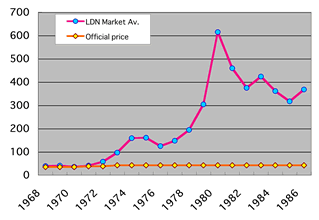 Gold Office Price vs. London Market
Price (Ave.) per oz-t.
Gold Office Price vs. London Market
Price (Ave.) per oz-t.
(1968-86):
- >Top The above chart is the comparison of gold market price at London
since dual price system in 1986. London market price is determined
by quotations from 5 major traders like N.M. Rothschilds & Sons,
Samuel Montague, etc. The drop in 1976 was due to the discharge
of gold by IMF. (Cf: $332/oz-t as of 2003.4)
- >Top Gold reserve and its evaluation
in major countries (1998.1):
- The left scale is evaluation price (yellow bar) and the right
scale is the volume of gold reserve (red line) of
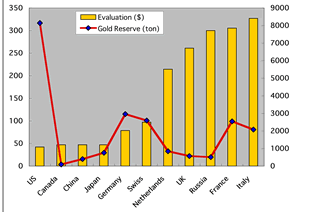 major countries
in $/oz-t.
major countries
in $/oz-t.
- The above chart shows the total gold reserve of EU (even excluding
20% of the deposit to EMF) exceeds the total of US.
- Gold mining cost is said about $260/oz-t.
- There are two opinions about gold: "Demonetarization of gold"
and "active user of gold."
- 最後の頼りは金:
ニクソンショック後も、将来の固定相場制と金本位制へ復帰を巡る進学論争が続いていた。
- 1974.12: 米仏、公的金準備の市場価格での再評価発表。→途上国の一斉反発:金廃貨論を説いておきながら、金準備の再評価で巨額な利益を上げることへの反発
- 1976-80: IMF所有金の1/6 (777トン)を旧公定価格($42.22)で出資国へ売り戻り、残り1/6は市場で競売
- 金公定価格、対ロンドン市場価格:
トロイオンス平均 (1968-1986)
1986年に金が二重価格制になって以来の金市場の推移。ロンドン金市場はN.M.ロスチャイルド&サンズ、サミュエル・モンタギュ等の5大業者の売買注文で相場を形成。なお、1976年の下落はIMFの金の市場放出による。
参考:$332/oz-t (2003.4)
- 主要国の公的金準備量とその評価基準:
(1988) 公的準備量は右軸、評価基準は左軸、いずれも$/oz-t。
- 左図はまた、EUの金準備量(EMFへの拠出金20%を除いてもなお)、米国の金準備量を上回る。
- 金の採掘コストは約$260/oz-t
- 金に関しては2つの意見がある、「金廃貨派」と「金の積極活用派」である。
>Top Comment
- Gold has been a standard of currency backed by the Gold Standard
System and the fixed office price of gold in most of 20c.
- But since 1971 by the announcement of Nixon shock, conversion
of dollar to gold has been suspended, and money flow rapidly grows
exceeding real economy. Where has gone the creditability of currency?
- In 21st century, three credit named Gold, Currency,
and probably Ecomoney will sustain our global-local community.
- 金は20世紀の長い間、金本位制と一定の公定価格で貨幣信任の基準であった。
- しかし、1971年のニクソンショックの発表以来、金とドルとの交換停止となり、また実体経済を遙かに超えての急速な貨幣流通量の増大に伴い、貨幣への信頼はどこへいったのだろうか。
- 21世紀には、このゴールドと通貨と、そしておそらくエコマネーが補完的に支えながら、グローバル&ローカル社会を支えていくことになろう。
 |
Gold tells 20th century
|
Cat: ECOPub: 1999#:0224b |
Toyoyuki Sameda |
02531u/18129r |
| Title | Gold tells 20th century |
金が語る20世紀 |
|---|---|---|
| Author | Toyoyuki Sameda | 鮫田豊之 |
| Index | ||
| Why? |
|
|
>Top Gold Reserve of sum of Japanese Government & Bank of Japan (1905-36,
1950-70, and 1998) Unit: Au. ton |
|
>Top 0. Gold Reserve of Japan:
|
0. 日本の金準備:
|
>Top 1. World War I and Fall of Gold Standard:
|
1. 第一次大戦と金本位制の停止:
|
>Top 2. Between World War I and II:
|
2.二つの大戦の間で:
|
>Top 3. World War II and Transport of Gold:
|
3. 太平洋戦争と金輸送:
|
|
|
>Top 4. Aiming to be Economic Power:
|
4. 経済大国をめざして:
|
|
|
|
<左図>英/仏/西独/日の金準備高 (1950-60):
|
>Top US/Swiss/W-Germany/Japan Gold Reserve & Foreign Currency Reserve (1955 - 1970):
|
<下図> 米・スイス・西独・日の金準備高+外貨準備高(1955-1970):
|
>Top US/Swiss/W-Germany/Japan Gold Reserve & Foreign Currency (1955 - 1970):
|
|
>Top 5. Uncharted Navigation:
|
5.海図なき航海:
|
|
|
>Top Comment |
|
|